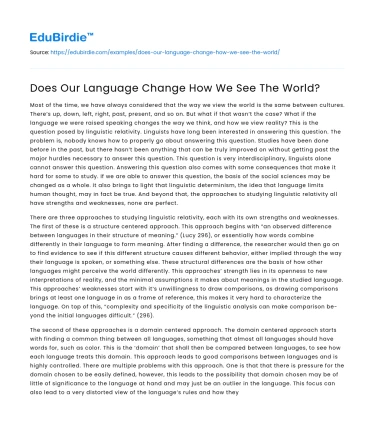Most of the time, we have always considered that the way we view the world is the same between cultures. There’s up, down, left, right, past, present, and so on. But what if that wasn’t the case? What if the language we were raised speaking changes the way we think, and how we view reality? This is the question posed by linguistic relativity. Linguists have long been interested in answering this question. The problem is, nobody knows how to properly go about answering this question. Studies have been done before in the past, but there hasn’t been anything that can be truly improved on without getting past the major hurdles necessary to answer this question. This question is very interdisciplinary, linguists alone cannot answer this question. Answering this question also comes with some consequences that make it hard for some to study. If we are able to answer this question, the basis of the social sciences may be changed as a whole. It also brings to light that linguistic determinism, the idea that language limits human thought, may in fact be true. And beyond that, the approaches to studying linguistic relativity all have strengths and weaknesses, none are perfect.
There are three approaches to studying linguistic relativity, each with its own strengths and weaknesses. The first of these is a structure centered approach. This approach begins with “an observed difference between languages in their structure of meaning.” (Lucy 296), or essentially how words combine differently in their language to form meaning. After finding a difference, the researcher would then go on to find evidence to see if this different structure causes different behavior, either implied through the way their language is spoken, or something else. These structural differences are the basis of how other languages might perceive the world differently. This approaches’ strength lies in its openness to new interpretations of reality, and the minimal assumptions it makes about meanings in the studied language. This approaches’ weaknesses start with it’s unwillingness to draw comparisons, as drawing comparisons brings at least one language in as a frame of reference, this makes it very hard to characterize the language. On top of this, “complexity and specificity of the linguistic analysis can make comparison be-yond the initial languages difficult.” (296).
Save your time!
We can take care of your essay
- Proper editing and formatting
- Free revision, title page, and bibliography
- Flexible prices and money-back guarantee
The second of these approaches is a domain centered approach. The domain centered approach starts with finding a common thing between all languages, something that almost all languages should have words for, such as color. This is the ‘domain’ that shall then be compared between languages, to see how each language treats this domain. This approach leads to good comparisons between languages and is highly controlled. There are multiple problems with this approach. One is that that there is pressure for the domain chosen to be easily defined, however, this leads to the possibility that domain chosen may be of little of significance to the language at hand and may just be an outlier in the language. This focus can also lead to a very distorted view of the language’s rules and how they would approach a situation in their language. The other issue is that when a domain is chosen, they are most likely choosing it from a point of view in their language. When they choose what to include or not in the domain, their language puts a bias on the criteria immediately. Finally, it’s common for studies adopting the domain approach to have difficulty showing what effects on behavior the chosen domain causes, as they are likely to find a domain that is not often spoken habitually, just a domain that is possible to use.
The third approach is a behavior centered approach. This done essentially by observing a strange behavior and coming to find that it is cause by thoughts formed through their language. The strength in this approach “lies in the significance of the behavior, which typically has clear practical consequences either for theory or to native speakers.” (302). The problem with this approach is that it is very spontaneous and is very likely that while the observer or speaker finds this behavior noticeable, it may not be all that important to the function or structure of the language. On top of this “Often no formal analysis of the language is undertaken and no comparison with other languages is attempted.” (302).
Trying to prove linguistic relativity is a hard task for those studying it. The sheer number of problems with forming a study, and the possible ramifications society as a whole if it is proven are sure to stop many of those who have any interest in studying it. However, if somebody succeeds, the result will be seen throughout the social sciences, and our understanding of human language and culture will be elevated.
Bibliography
- Lucy, John A. “Linguistic Relativity.” Annual Review of Anthropology, vol. 26, no. 1, 1997, pp. 291–312., doi:10.1146/annurev.anthro.26.1.291.






 Stuck on your essay?
Stuck on your essay?

